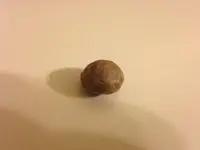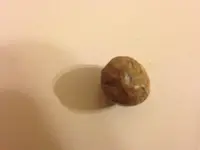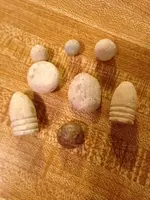Clf_02 asked me to comment. (I've been busy dealing with preparations for the blizzard, and then shoveling snow.)
Before talking about the cause of the heavy encrustation, let's deal with figuring out what your "lead ball" was used for. As others have suggested, I too believe it is a fired musketball or pistolball, which got "smushed" out-of-round by impact with the ground or a tree. It could also be a Case-Shot ball from an antipersonnel artillery shell -- but since you haven't reported finding artillery shell fragments at that spot, that would tend to exclude it from being a Case-Shot ball.
Firing and impact can change the shape of a bullet or musket/pistol ball... but its weight doesn't get changed. So, its weight can be a useful ID-clue. Please get that "lead ball" weighed on a Jeweler's scale, which weighs in grams or grains. Then we can "do the math" to calculate the ball's original diameter.
At first, I thought the cause of the heavy encrustation was soil-chemistry. Thank you for adding the information that other lead objects from that spot come out of the ground without the thick encrustation. That fact indicates that the answer is the chemistry of the "lead" ball itself. It is probably not pure-lead (100% lead), but instead is a lead-alloy. It MIGHT be a pre-civil-war homemade ball... made from tossing pieces of whatever various White-Metals were handy into the melting-pot. If it is a homemade musketball, it could be a "polyglot" mixture of some lead with pewter and/or tin and/or zinc and/or solder, and/or gosh knows what else. I think that is what is responsible for the thick encrustation forming on it but not on the pure-lead balls and bullets dug nearby.






